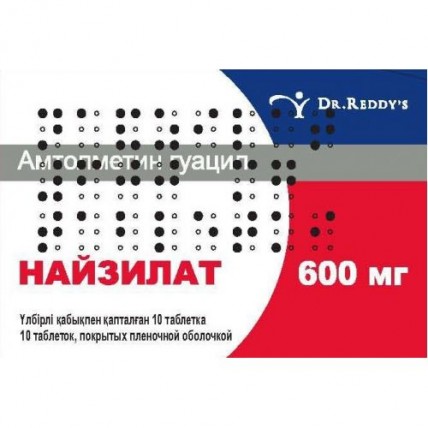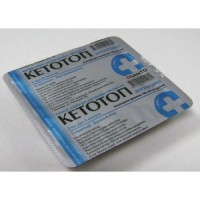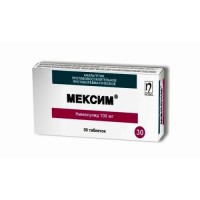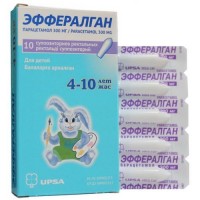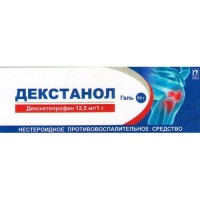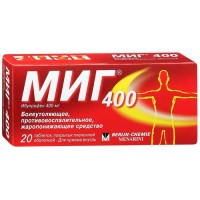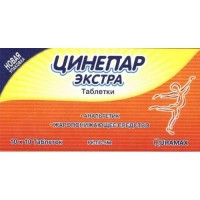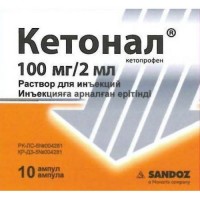Nayzilat 10s 600 mg film-coated tablets
- $15.80
Out Of Stock
The instruction for medical use
of Nayzilat Torgovoye medicine a name
Nayzilat
Mezhdunarodnoye
guatsit the unlicensed name Amtolmetin
the Dosage form
of the Tablet, film coated, 600 mg
Structure
One tablet contains
active agent - amtolmetin guatsit 600 mg,
excipients: lactoses monohydrate, the gipromelloza of 15 cps, silicon dioxide colloidal anhydrous, sodium of starch glikolit (type A), magnesium stearate,
structure of a cover: gipromelloza of 5 cps, titan E 171 dioxide, macrogoal (PEG 400).
The description
of the Tablet of a form kaplt, film coated from white till almost white color, smooth on both sides.
Pharmacotherapeutic group
Non-steroidal anti-inflammatory drugs. Acetic acid derivatives.
The ATX M01AB code
the Pharmacological
Pharmacokinetics Absorption properties amtolmetin a guatsila after intake happens quickly and completely. Amtolmetin guatsit concentrates generally in a gastrointestinal wall where its maximum level concentrates within 2 hours after administration of drug. Its transformation into active metabolites happens as soon as he enters plasma so he amtolmetin guatsit per se, it is hardly found in blood plasma and in fabrics.
Amtolmetin guatsit is hydrolyzed by plasma esterases on the following metabolites: MED5, tolmetin and guaiacol. MED5 (tolmetin-glitsinamid) is the main metabolite in blood plasma. Tolmetin-glitsinamid is metabolized to a tolmetin and an active metabolite and reaches high concentration in fabrics. Drug removal almost full within 24 hours also happens mainly to urine (77% of the entered dose) in the form of glucuronides. A small amount is removed with bile and excrements (7.5%).
A pharmacodynamics
Amtolmetin guatsit is the non-steroidal anti-inflammatory drug (NPVS), pro-medicine of a tolmetin possessing soothing and anti-inflammatory action. Guatsit the main mechanism of action of an amtolmetin, as well as at other NPVS, it is shown in inhibition of COG and synthesis of prostaglandins. Amtolmetin increases the level of antioxidant enzymes in a mucous membrane of a stomach, such as superoxide scavenger (SOD), catalase, glutathione, at simultaneous decrease in level super-oxide of anion, peroxide nitrites or peroxide chloride and also low-new dialdehyde. Besides, at use of an amtolmetin the level of nitrogen oxide (NO) in a stomach increases that is shown by gastroprotektorny effect of drug.
Antioxidant action of an amtolmetin can have additional value at treatment of patients with the osteoarthritis which is followed by inflammation and pain at which the oxidizing stress, injury of cartilages by free radicals increases. Decrease in pain when using an amtolmetin is also connected with reduction of level of the nitrogen oxide promoting overcoming an oxidizing stress.
These two effects are selective and specific, at use of an amtolmetin.
Indications
- an osteoarthritis, a pseudorheumatism, an arthralgia, myalgia, pains after injuries
the Route of administration and doses
take the Drug inside, with enough liquid. Nayzilat it is necessary to appoint on an empty stomach to keep its gastroprotektorny effect.
Adults
On 600 mg twice a day.
The recommended dose makes 600 mg twice a day, the maintenance dose can be reduced to 600 mg.
Use for elderly patients
For patients of advanced age (65 years are more senior), at which function of kidneys, as a rule, decreases, and shipping of NPVS digestive tract decreases, appointed a low dosage (600 mg once a day) amtolmetin guatsit.
Duration of treatment is established by the doctor depending on features of a course of the disease and weight of a state. It is not recommended for long-term treatment.
Side effects
- lack of appetite, increase in appetite, dryness in a mouth, a glossitis, stomatitis, an oral cavity ulceration, a stomacace, bleeding of gums, a dysphagy, an eructation, nausea, vomiting, an esophagitis, gastritis, a gastroenteritis, enteritis, an abdominal distension, dyspepsia, an abdominal pain, colitis, rectal bleeding, pains in a gall bladder, a peptic ulcer of a stomach and duodenum, diarrhea, a tar-like chair, a constipation, tenesmus, hepatitis, an abnormal liver function, pancreatitis, cholestatic jaundice
- a nasopharyngitis, rhinitis, nasal bleeding, bronchitis, pneumonia, an asthma, asthma, a laryngeal edema
- insomnia, drowsiness, disturbing dreams, a headache, dizziness, paresthesia, a hypesthesia, amnesia, emotional instability, a lack of coordination, peripheral neuropathy, a wryneck, paralysis of a facial nerve, a hyperkinesia, a depression, hypotonia
- an arthralgia, arthritis, spasms in the lower extremities, a bursitis, a tendovaginitis, a rupture of a sinew, a myasthenia, myalgia, a contracture of muscles, myotonia, a miositis, a myopathy, a rhabdomyolysis
- an itching, contact dermatitis, baldness, xeroderma, the increased perspiration, a small tortoiseshell, eczema, seborrhea, skin ulcers
- infections of an uric path, frequent urination, cystitis, a hamaturia, a dysuria, concrements in kidneys, a nocturia, an albuminuria, nephrite, urine incontinence, an ischuria, desires on urination
- the epididymite, impotence, decrease a libido, a premature ejaculation, fibrous and cystous mastopathy, vaginal bleeding, acyclic uterine bleeding
- a thorax hypertrophy
- an amblyopia, xerophthalmus, disturbance of a refraction, hemorrhage in eyes, glaucoma, a ring in ears, deafness, a parosmiya, loss of taste, a food faddism
- heartbeat, a vazodilatation, a faint, migraine, orthostatic hypotension, phlebitis, arrhythmia, stenocardia, arterial hypertension
- peripheral swelled, a hyperglycemia, a hypoglycemia, increase in level of a kreatininfosfokinaza, gout, increase in body weight
- bruises, anemia, a hyperadenosis, a lymphadenopathy, thrombocytopenia, an agranulocytosis, a leukopenia, petekhialny hemorrhage
- a stethalgia, a dorsodynia, a face edema, a paraglossa, fever, muscle tension of a neck, orientation disturbance, the increased reaction of photosensitivity, generalized swelled, an anaphylaxis, a Quincke's disease, bubble rash (including a multiformny erythema, Stephens-Johnson's syndrome and a toxic epidermal necrolysis, a Lyell's disease), acute necrosis of skeletal muscles
of the Contraindication
- hypersensitivity to any of drug components
- intolerance of other non-steroidal anti-inflammatory drugs and to patients, with a full or incomplete combination of bronchial asthma, rhinitis, urticaria
- GIT erosive cankers (a peptic ulcer of a stomach and duodenum, inflammatory bowel diseases (ulcer colitis, Crohn's disease)
- dekompensirovanny heart failure, swell, arterial hypertension, hemophilia, hypocoagulation
- insufficiency of function of a liver or an active disease of a liver
- chronic kidney disease (KK & lt, 30 ml/min.), the progressing diseases of kidneys
- the confirmed hyperpotassemia
- decrease in hearing, pathology of a vestibular mechanism
- pregnancy and the period of a lactation
-
- active gastrointestinal bleeding, cerebrovascular or other bleeding
- the period after performing aortocoronary shunting
- deficit glyukozo-6-fosfatdegidrogenazy
With care to apply children's age up to 18 years at a hyperbilirubinemia.
- chronic heart failure, coronary heart disease, cerebrovascular diseases
- dislipidemiya / a lipidemia, diabetes
- diseases of peripheral arteries, smoking
- chronic kidney disease (KK of 30-60 ml/min.)
- digestive tract cankers in the anamnesis, presence of an infection of H.pylori, long use NPVS, alcoholism, heavy somatopathies, advanced age
- a concomitant use of oral glucocorticosteroids (including, Prednisolonum), anticoagulants (including, warfarin), antiagregant (including, acetylsalicylic acid, klopidogrelya), selective serotonin reuptake inhibitors (including, a tsitaloprama, fluoxetine, a paroksetin, sertraline).
Medicinal interactions
H1-gistaminoblokatory, as we know, interfere with capsaicin receptors. It is necessary to avoid simultaneous use amtolmetin a guatsil with H1 - gistaminoblokator
of NPVS can strengthen effect of anticoagulants, such as warfarin, the risk of gastrointestinal bleeding or ulcer at combined use with corticosteroids is possible and antiagregant. NPVS can reduce antihypertensive effect of diuretics, APF inhibitors and other antihypertensives. At some patients with renal failures, combined use of NPVS and APF inhibitors can lead to further deterioration in function of kidneys. These interactions have to be taken into account when using amtolmetin a guatsila in combination with APF inhibitors.
Inductors of microsomal oxidation in a liver (Phenytoinum, ethanol, barbiturates, rifampicin, phenylbutazone, tricyclic antidepressants) increase products of hydroxylated active metabolites. Reduces efficiency of uricosuric medicines, enhances hypoglycemic effect of derivatives of sulphonylurea. Antacids and Colestyraminum reduce absorption of an amtolmetin. Increase concentration in blood of lithium, a methotrexate. Myelotoxic medicines strengthen manifestations of a gematotoksichnost of drug.
Special instructions
At patients with a liver or renal failure, treatment amtolmetin guatsily has to take place under clinical monitoring, with periodic control of function of kidneys and a liver. In case of deterioration in function of kidneys and a liver, treatment has to be suspended. Patients in whose anamnesis the therapy of a coagulopathy, treatment by anticoagulants took place have to be under careful medical control. During treatment the control of a picture of peripheral blood is necessary. As at the patients receiving other NPVS changes from eyes were registered, in case of development of visual disturbances during treatment amtolmetin guatsily, treatment ophthalmologic examination has to be stopped and performed. At emergence of any allergic reaction, treatment has to be immediately stopped. Treatment should be stopped in 48 hours prior to definition of 17 ketosteroids.
Monohydrate is a part of drug lactoses, in this regard Nayzilat is not recommended to patients with hereditary intolerance of a galactose, deficiency of Lappa lactase, malabsorption of a glucose/galactose.
Use
Safety and efficiency during pregnancy and a lactation are not established to pregnant women or the feeding women.
Features of influence of medicine on ability to run the vehicle or potentially dangerous mechanisms
Drug can cause dizziness and drowsiness therefore during treatment the patients should not run the vehicle or potentially dangerous mechanisms.
Overdose
Symptoms: disorders of vision, tachycardia, dryness in a mouth, nausea, vomiting, the increased sweating.
Treatment: gastric lavage, intake of activated carbon, symptomatic therapy.
The form of release and packing
On 10 tablets place in blister strip packaging from a film of polyvinylchloride and aluminum foil.
On 1 planimetric packing together with the instruction for medical use in the state and Russian languages place in a pack from cardboard bandbox.
To Store storage conditions in the dry, protected from light place at a temperature not above 25 °C
to Store out of children's reach!
2 years
not to apply a period of storage after an expiration date.
Prescription status
According to the prescription
the Producer "Dr. of Reddi's Laboratoris Limited" Site No.: 42.45 and 46,
Bachupali Villadzh, Kutubullapur Mandal, Region of the Rank of Redi, Andhra Pradesh, India
the Name and the country the owner of the registration certificate:
"The Dr. of Reddi's Laboratoris Limited", India
the Address of the organization accepting in the territory of the Republic of Kazakhstan claims from consumers on quality of products:
Representative office "Dr. of Reddi's Laboratoris Limited" in Republic of Kazakhstan, 050057 Almaty, 22nd Line St., 45,
a post office box 7,
ph. 8 (727) 3941688
fax: 8 (727) 3941294
To develop
of Nayzilat Torgovoye medicine a name
Nayzilat
Mezhdunarodnoye
guatsit the unlicensed name Amtolmetin
the Dosage form
of the Tablet, film coated, 600 mg
Structure
One tablet contains
active agent - amtolmetin guatsit 600 mg,
excipients: lactoses monohydrate, the gipromelloza of 15 cps, silicon dioxide colloidal anhydrous, sodium of starch glikolit (type A), magnesium stearate,
structure of a cover: gipromelloza of 5 cps, titan E 171 dioxide, macrogoal (PEG 400).
The description
of the Tablet of a form kaplt, film coated from white till almost white color, smooth on both sides.
Pharmacotherapeutic group
Non-steroidal anti-inflammatory drugs. Acetic acid derivatives.
The ATX M01AB code
the Pharmacological
Pharmacokinetics Absorption properties amtolmetin a guatsila after intake happens quickly and completely. Amtolmetin guatsit concentrates generally in a gastrointestinal wall where its maximum level concentrates within 2 hours after administration of drug. Its transformation into active metabolites happens as soon as he enters plasma so he amtolmetin guatsit per se, it is hardly found in blood plasma and in fabrics.
Amtolmetin guatsit is hydrolyzed by plasma esterases on the following metabolites: MED5, tolmetin and guaiacol. MED5 (tolmetin-glitsinamid) is the main metabolite in blood plasma. Tolmetin-glitsinamid is metabolized to a tolmetin and an active metabolite and reaches high concentration in fabrics. Drug removal almost full within 24 hours also happens mainly to urine (77% of the entered dose) in the form of glucuronides. A small amount is removed with bile and excrements (7.5%).
A pharmacodynamics
Amtolmetin guatsit is the non-steroidal anti-inflammatory drug (NPVS), pro-medicine of a tolmetin possessing soothing and anti-inflammatory action. Guatsit the main mechanism of action of an amtolmetin, as well as at other NPVS, it is shown in inhibition of COG and synthesis of prostaglandins. Amtolmetin increases the level of antioxidant enzymes in a mucous membrane of a stomach, such as superoxide scavenger (SOD), catalase, glutathione, at simultaneous decrease in level super-oxide of anion, peroxide nitrites or peroxide chloride and also low-new dialdehyde. Besides, at use of an amtolmetin the level of nitrogen oxide (NO) in a stomach increases that is shown by gastroprotektorny effect of drug.
Antioxidant action of an amtolmetin can have additional value at treatment of patients with the osteoarthritis which is followed by inflammation and pain at which the oxidizing stress, injury of cartilages by free radicals increases. Decrease in pain when using an amtolmetin is also connected with reduction of level of the nitrogen oxide promoting overcoming an oxidizing stress.
These two effects are selective and specific, at use of an amtolmetin.
Indications
- an osteoarthritis, a pseudorheumatism, an arthralgia, myalgia, pains after injuries
the Route of administration and doses
take the Drug inside, with enough liquid. Nayzilat it is necessary to appoint on an empty stomach to keep its gastroprotektorny effect.
Adults
On 600 mg twice a day.
The recommended dose makes 600 mg twice a day, the maintenance dose can be reduced to 600 mg.
Use for elderly patients
For patients of advanced age (65 years are more senior), at which function of kidneys, as a rule, decreases, and shipping of NPVS digestive tract decreases, appointed a low dosage (600 mg once a day) amtolmetin guatsit.
Duration of treatment is established by the doctor depending on features of a course of the disease and weight of a state. It is not recommended for long-term treatment.
Side effects
- lack of appetite, increase in appetite, dryness in a mouth, a glossitis, stomatitis, an oral cavity ulceration, a stomacace, bleeding of gums, a dysphagy, an eructation, nausea, vomiting, an esophagitis, gastritis, a gastroenteritis, enteritis, an abdominal distension, dyspepsia, an abdominal pain, colitis, rectal bleeding, pains in a gall bladder, a peptic ulcer of a stomach and duodenum, diarrhea, a tar-like chair, a constipation, tenesmus, hepatitis, an abnormal liver function, pancreatitis, cholestatic jaundice
- a nasopharyngitis, rhinitis, nasal bleeding, bronchitis, pneumonia, an asthma, asthma, a laryngeal edema
- insomnia, drowsiness, disturbing dreams, a headache, dizziness, paresthesia, a hypesthesia, amnesia, emotional instability, a lack of coordination, peripheral neuropathy, a wryneck, paralysis of a facial nerve, a hyperkinesia, a depression, hypotonia
- an arthralgia, arthritis, spasms in the lower extremities, a bursitis, a tendovaginitis, a rupture of a sinew, a myasthenia, myalgia, a contracture of muscles, myotonia, a miositis, a myopathy, a rhabdomyolysis
- an itching, contact dermatitis, baldness, xeroderma, the increased perspiration, a small tortoiseshell, eczema, seborrhea, skin ulcers
- infections of an uric path, frequent urination, cystitis, a hamaturia, a dysuria, concrements in kidneys, a nocturia, an albuminuria, nephrite, urine incontinence, an ischuria, desires on urination
- the epididymite, impotence, decrease a libido, a premature ejaculation, fibrous and cystous mastopathy, vaginal bleeding, acyclic uterine bleeding
- a thorax hypertrophy
- an amblyopia, xerophthalmus, disturbance of a refraction, hemorrhage in eyes, glaucoma, a ring in ears, deafness, a parosmiya, loss of taste, a food faddism
- heartbeat, a vazodilatation, a faint, migraine, orthostatic hypotension, phlebitis, arrhythmia, stenocardia, arterial hypertension
- peripheral swelled, a hyperglycemia, a hypoglycemia, increase in level of a kreatininfosfokinaza, gout, increase in body weight
- bruises, anemia, a hyperadenosis, a lymphadenopathy, thrombocytopenia, an agranulocytosis, a leukopenia, petekhialny hemorrhage
- a stethalgia, a dorsodynia, a face edema, a paraglossa, fever, muscle tension of a neck, orientation disturbance, the increased reaction of photosensitivity, generalized swelled, an anaphylaxis, a Quincke's disease, bubble rash (including a multiformny erythema, Stephens-Johnson's syndrome and a toxic epidermal necrolysis, a Lyell's disease), acute necrosis of skeletal muscles
of the Contraindication
- hypersensitivity to any of drug components
- intolerance of other non-steroidal anti-inflammatory drugs and to patients, with a full or incomplete combination of bronchial asthma, rhinitis, urticaria
- GIT erosive cankers (a peptic ulcer of a stomach and duodenum, inflammatory bowel diseases (ulcer colitis, Crohn's disease)
- dekompensirovanny heart failure, swell, arterial hypertension, hemophilia, hypocoagulation
- insufficiency of function of a liver or an active disease of a liver
- chronic kidney disease (KK & lt, 30 ml/min.), the progressing diseases of kidneys
- the confirmed hyperpotassemia
- decrease in hearing, pathology of a vestibular mechanism
- pregnancy and the period of a lactation
-
- active gastrointestinal bleeding, cerebrovascular or other bleeding
- the period after performing aortocoronary shunting
- deficit glyukozo-6-fosfatdegidrogenazy
With care to apply children's age up to 18 years at a hyperbilirubinemia.
- chronic heart failure, coronary heart disease, cerebrovascular diseases
- dislipidemiya / a lipidemia, diabetes
- diseases of peripheral arteries, smoking
- chronic kidney disease (KK of 30-60 ml/min.)
- digestive tract cankers in the anamnesis, presence of an infection of H.pylori, long use NPVS, alcoholism, heavy somatopathies, advanced age
- a concomitant use of oral glucocorticosteroids (including, Prednisolonum), anticoagulants (including, warfarin), antiagregant (including, acetylsalicylic acid, klopidogrelya), selective serotonin reuptake inhibitors (including, a tsitaloprama, fluoxetine, a paroksetin, sertraline).
Medicinal interactions
H1-gistaminoblokatory, as we know, interfere with capsaicin receptors. It is necessary to avoid simultaneous use amtolmetin a guatsil with H1 - gistaminoblokator
of NPVS can strengthen effect of anticoagulants, such as warfarin, the risk of gastrointestinal bleeding or ulcer at combined use with corticosteroids is possible and antiagregant. NPVS can reduce antihypertensive effect of diuretics, APF inhibitors and other antihypertensives. At some patients with renal failures, combined use of NPVS and APF inhibitors can lead to further deterioration in function of kidneys. These interactions have to be taken into account when using amtolmetin a guatsila in combination with APF inhibitors.
Inductors of microsomal oxidation in a liver (Phenytoinum, ethanol, barbiturates, rifampicin, phenylbutazone, tricyclic antidepressants) increase products of hydroxylated active metabolites. Reduces efficiency of uricosuric medicines, enhances hypoglycemic effect of derivatives of sulphonylurea. Antacids and Colestyraminum reduce absorption of an amtolmetin. Increase concentration in blood of lithium, a methotrexate. Myelotoxic medicines strengthen manifestations of a gematotoksichnost of drug.
Special instructions
At patients with a liver or renal failure, treatment amtolmetin guatsily has to take place under clinical monitoring, with periodic control of function of kidneys and a liver. In case of deterioration in function of kidneys and a liver, treatment has to be suspended. Patients in whose anamnesis the therapy of a coagulopathy, treatment by anticoagulants took place have to be under careful medical control. During treatment the control of a picture of peripheral blood is necessary. As at the patients receiving other NPVS changes from eyes were registered, in case of development of visual disturbances during treatment amtolmetin guatsily, treatment ophthalmologic examination has to be stopped and performed. At emergence of any allergic reaction, treatment has to be immediately stopped. Treatment should be stopped in 48 hours prior to definition of 17 ketosteroids.
Monohydrate is a part of drug lactoses, in this regard Nayzilat is not recommended to patients with hereditary intolerance of a galactose, deficiency of Lappa lactase, malabsorption of a glucose/galactose.
Use
Safety and efficiency during pregnancy and a lactation are not established to pregnant women or the feeding women.
Features of influence of medicine on ability to run the vehicle or potentially dangerous mechanisms
Drug can cause dizziness and drowsiness therefore during treatment the patients should not run the vehicle or potentially dangerous mechanisms.
Overdose
Symptoms: disorders of vision, tachycardia, dryness in a mouth, nausea, vomiting, the increased sweating.
Treatment: gastric lavage, intake of activated carbon, symptomatic therapy.
The form of release and packing
On 10 tablets place in blister strip packaging from a film of polyvinylchloride and aluminum foil.
On 1 planimetric packing together with the instruction for medical use in the state and Russian languages place in a pack from cardboard bandbox.
To Store storage conditions in the dry, protected from light place at a temperature not above 25 °C
to Store out of children's reach!
2 years
not to apply a period of storage after an expiration date.
Prescription status
According to the prescription
the Producer "Dr. of Reddi's Laboratoris Limited" Site No.: 42.45 and 46,
Bachupali Villadzh, Kutubullapur Mandal, Region of the Rank of Redi, Andhra Pradesh, India
the Name and the country the owner of the registration certificate:
"The Dr. of Reddi's Laboratoris Limited", India
the Address of the organization accepting in the territory of the Republic of Kazakhstan claims from consumers on quality of products:
Representative office "Dr. of Reddi's Laboratoris Limited" in Republic of Kazakhstan, 050057 Almaty, 22nd Line St., 45,
a post office box 7,
ph. 8 (727) 3941688
fax: 8 (727) 3941294
To develop
